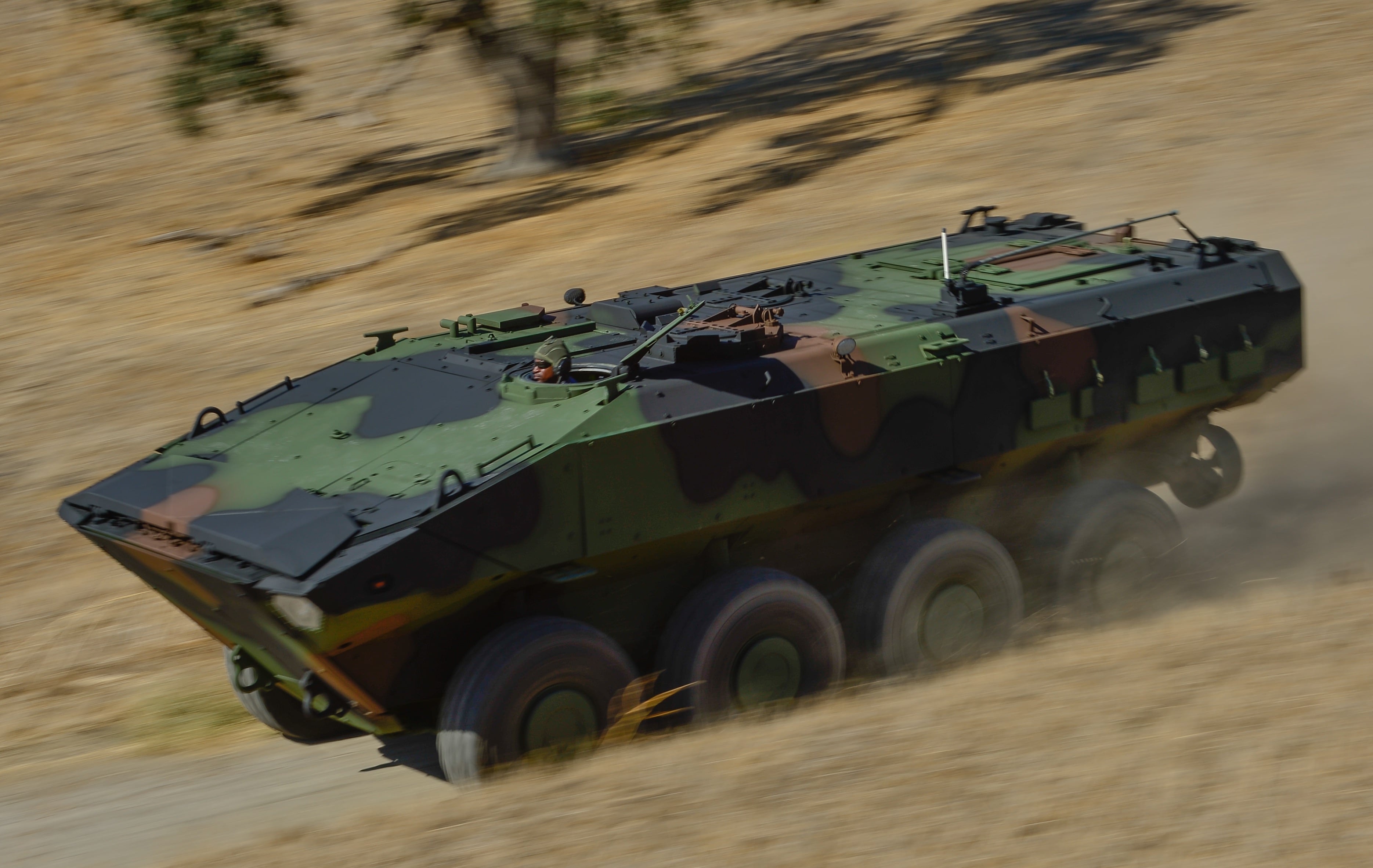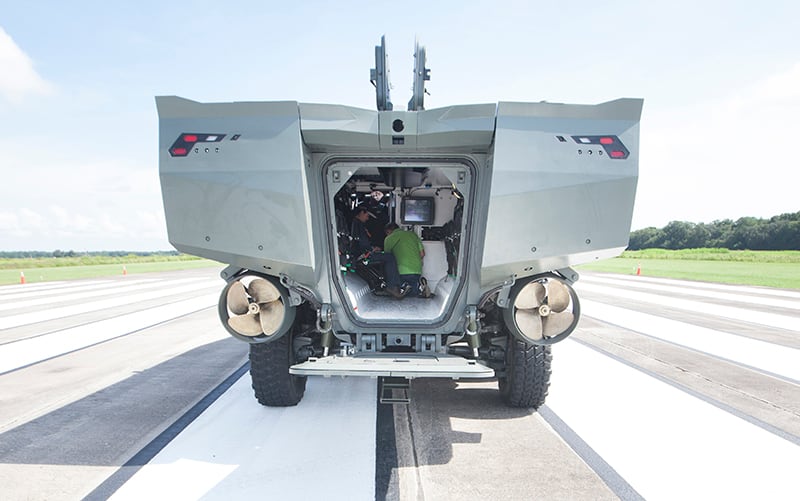The battle to build the amphibious combat vehicle is down to two competitors, and both prototypes promise a better ride than the amphibious assault vehicle the Corps wants looks to replace.
Indeed, Marines may feel spoiled by either ACV. Both are eight-wheeled vehicles that are more quiet and comfortable than the tracked AAV. The hot exhaust that has nauseated many a Marine has been erased by air conditioning and better ventilation.
BAE Systems and SAIC beat out three other manufacturers in a competition to build engineering and manufacturing development prototypes of the vehicle that will ferry Marines ashore and into battle. General Dynamics Land Systems has protested the award.
Each of the winning companies, announced Nov. 24, will build 16 eight-wheeled vehicles to be tested over the next two years. The service is expected to pick a winner in 2018 to deliver 204 vehicles by 2020.
Both companies have a long history with amphibious vehicles. BAE built the original AAV. SAIC’s partner, ST Kinetics, built the hundreds of Terrex 1 vehicles currently used by Singapore. Both BAE and SAIC also had contracts tied to the Marine Corps' push to modernize its fleet of AAVs. Both companies have had Assault Amphibious Vehicle Reliability, Availability, Maintainability/Rebuild to Standard contracts.
While the Vietnam-era AAV can carry 25 Marines, the ACV reduces capacity by nearly half to increase survivability and maneuverability. Here are some key differences you can expect between the two competitors:

BAE's version of the amphibious combat vehicle can reach speeds of 65 mph on paved roads and 6 knots in the open ocean. It is better than 28 feet long, 10 feet wide and 9 feet in height.
Photo Credit: David Schacher/BAE
The BAE's amphibious combat vehicle ACV has little in common with its predecessor. The ACV weighs is new vehicle comes in at 63,000 pounds and has a payload capacity of 6,000 pounds. It can reach speeds of 65 mph on paved roads, 6 knots in the open ocean, and has a range of 350 miles or 10 nautical miles at sea followed by 200 miles on land. It is better than 28 feet long, 10 feet wide and 9 feet in height. External tanks keep fuel away from crew and passengers.
John Swift, BAE's ACV program manager pointed to the 8x8 wheeled design as the key difference Marines can expect when compared to their current amphib.
"That allows for optimized hull design and affords MRAP-level survivability," he said. "Our vehicle has the same water mobility as the current system, with an increase in land mobility across the various terrain profiles. In our design, as allowed by the H-drive system in its 8x8 design with all-wheel drive, power and torque is maximized for soft soil and slope navigation to include the effort to self-recover onto amphibious shipping."
In addition, tThe unique H-drive system uses three drive shafts on each side of the vehicle, which means there are no axles.
Marine feedback and lessons-learned as the contract was developed led to upgrades such as increased stowage and improved seating arrangements — for example, capacity was increased to 13 embarked Marines plus a crew of three. This means the Marine squad will not have to regroup after hitting the beach.
"Operator feedback and experience from other ground combat platform design was further applied to the final design and functionality of the driver's instrument panel and gunner's controls that include push-button automation with a digital architecture," Swift said.
Survivability is the one improvement over the AAV that will most benefit Marine operators, he said. The vehicle affords "much greater direct fire and blast protection" through its integrated armor design and blast resistant hull; energy absorbing seats provide added protection.

SAIC's Terrex 2 amphibious combat vehicle can reach speeds of 55 mph on paved roads and 7 knots in the open ocean. It is nearly 28 feet long, 12 feet wide, and is 9 feet high.
Photo Credit: SAIC
SAIC's Terrex 1TERREX 1 is "a very mature platform" that has been tailored and upgraded to meet Marine Corps' requirements, according to Bernie Ellis, program manager.
The 65,000-pound Terrex 2 TERREX 2 has a "very good reserve buoyancy" and hydraulically driven propulsion systems that allow for easy operation and in sea-state 3 (calm but rippled waters), and safe operation in sea-state 4 (small chop with numerous whitecaps), and the ability to cut through through 6-foot plunging surf. It can reach speeds of 55 mph on paved roads, and officials expect an improvement of up to 15 percent. It can hit 7 knots in the open ocean. It is nearly 28 feet long, 12 feet wide, and is 9 feet high.
The Terrex 2 TERREX 2 carries a crew of three crew and 11 embarked Marines. It boasts a Remote Weapon System (.50 cal and 30mm cannon), and 10 Fusion cameras allow closed-hatch missions with day/night 360-degree situational awareness. Upgradeable, two-axle steering enables tight well-deck maneuvers while independent suspension improves ground mobility and ride quality. Its Central Tire Inflation System enables automated inflation and deflation of tires to accommodate different terrain while on the move.
Mobility and survivability is the one improvement over the AAV that will most benefit Marine operators, Ellis said. This is centered on a "cutting edge, V-over-V" hull design complemented by blast mitigating seats. Force protection from IEDs and enemy fire "translates to keeping Marines alive in combat, that's the bottom line," he said.
The current design includes many recommendations from lessons learned in Singapore, and continuous insight from former Marines employed by the company who "continue to support the Marine Corps by ensuring Marines have the ability to successfully execute their amphibious mission in an improved manner and a more survivable manner," said Tom Watson, senior vice president and lead for SAIC's Navy and Marine Corps Customer Group. "That's really a big deal to us."
One such retired Marine is Gary George, the program's deputy manager.
"I've tested many vehicles in the ocean, and … I would never put a Marine in a seat that's not been battle-tested by somebody that has the experience and the background," he said. "And I believe in this vehicle."
The Marine Corps on Nov. 24 selected BAE and SAIC as finalists to build the ACV. BAE's contract is for $103.8 million, while SAIC's is for $121.5 million. The 16 vehicles they each build Each company will build 16 vehicles that will endure rigorous tests over the next two years. The winner selected in 2018 The service will pick a winner in 2018. That company will deliver 204 vehicles, valued at $1.1 billion, by 2020. All vehicles are scheduled to be assigned to six battalions by the summer of 2023. The Corps also plans to modernize enough AAVs to outfit another four battalions. That would give the service the ability to put 10 battalions ashore during a forcible entry operation.
In its protest of the contract awards, General Dynamics Land Systems argued that saying the "selection process was not consistent with the criteria outlined in the RFP [request for proposals]." The Government Accounting Office has until March 16 to make a decision regarding the protest.
Lockheed Martin, another of the entrants, on Dec. 11 said it would not file a formal protest against the contracts.





